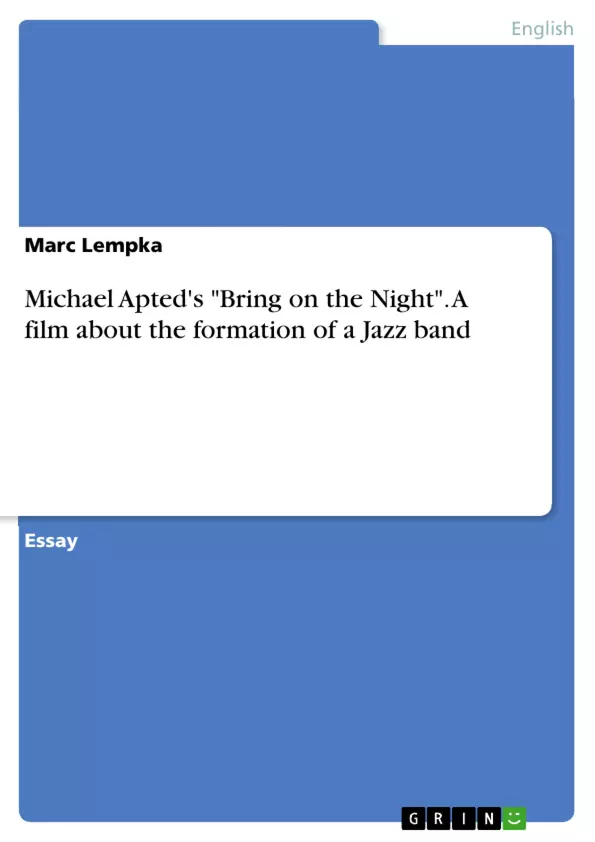In this work I would like to give an insight into the movie "Bring on the Night". The paper will start with general information about the movie and a short description of the plot. Furthermore it will try to categorize the film to a specific genre. A description of how the movie is shot follows. Additionally, the focus will be on social matters considering Jazz and the relation between the music and the content of the movie.
"Bring on the Night" is a film about the Pop musician Sting who is working on forming a Jazz band and preparing for a concert in France. The movie gives insights into the daily life of a busy musician, containing rehearsals and song-writing, but is also focused on the background of the musicians and the relationship between them. The movie won a Grammy award.
Inhaltsverzeichnis (Table of Contents)
- Introduction
- I. General Information
- II. Genre Categorization
- III. Structure and Look
- IV. Social Objects
- IV.I Jazz
- IV.II Cultural Differences
- IV.III Racism and Openness
- V. Relation between Music and Story
- Conclusion
Zielsetzung und Themenschwerpunkte (Objectives and Key Themes)
This work aims to offer an insightful analysis of the movie "Bring on the Night," focusing on its unique genre, structure, and social elements. It will explore the film's presentation of Jazz music and its relationship to the narrative, all within the context of cultural differences and the broader social landscape.
- Genre categorization of "Bring on the Night" as a hybrid of documentary and fictional elements
- The film's unique structure and visual style in contrast to traditional documentaries
- Social objects explored in the film, including the role of Jazz music
- Cultural differences and social dynamics presented within the context of the band formation
- The relationship between the music and the story, emphasizing the fusion of diverse musical styles
Zusammenfassung der Kapitel (Chapter Summaries)
The introduction provides a brief overview of the movie "Bring on the Night" and its focus on the formation of a Jazz band. The film's unique genre, structure, and social context are introduced as key areas of analysis.
Chapter I, "General Information," introduces the movie's central narrative of Sting forming a Jazz band, highlighting the daily life of a musician, including rehearsals, songwriting, and personal relationships among the band members. It also emphasizes the diverse backgrounds of the musicians, featuring prominent figures in Jazz history.
Chapter II, "Genre Categorization," explores the film's unconventional nature, defying traditional genre classification. It delves into the reasons why "Bring on the Night" cannot be classified solely as a documentary, highlighting the film's narrative structure and intentional blend of documentary and fictional elements.
Chapter III, "Structure and Look," analyzes the film's distinct visual style and editing techniques, contrasting them with typical documentary practices. It focuses on the film's use of short takes, dynamic perspectives, and fast cuts to create an immersive and engaging experience for the viewer, blurring the line between observation and participation.
Chapter IV, "Social Objects," delves into the social aspects of the film, exploring the role of Jazz music in the context of cultural differences and social dynamics. This section will investigate themes of racism, openness, and the construction of a shared musical language.
Schlüsselwörter (Keywords)
Key themes and topics explored in "Bring on the Night" include documentary filmmaking, hybrid genres, Jazz music, social commentary, cultural differences, musical collaboration, racism, openness, and narrative structure.
- Quote paper
- StR Marc Lempka (Author), 2007, Michael Apted's "Bring on the Night". A film about the formation of a Jazz band, Munich, GRIN Verlag, https://www.grin.com/document/320379



